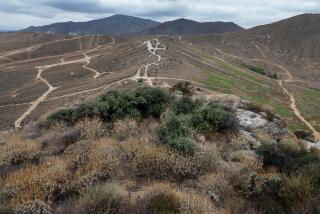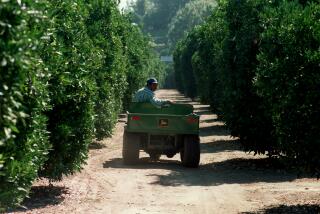Old Stone Barn to Be Restored in Park Plan : History: The work is part of a $9-million preservation project at Deukmejian Wilderness Park. The structure, built in 1911, is thought to be the oldest building in La Crescenta Valley.
- Share via
LA CRESCENTA — In the spring, an archeologist and work crews are expected to dig--literally--into La Crescenta’s past when they begin excavation of a historic barn.
The Glendale City Council on Tuesday approved initial work on restoration of an 81-year-old stone structure that is believed to be the oldest building in La Crescenta Valley. Work on the site, a former vineyard, will include removal of materials to expose the original concrete floor, stairs and foundation.
An archeologist will monitor the excavation to determine if historic materials are unearthed, according to a plan recommended earlier this month by the city’s Historic Preservation Commission. Officials plan to nominate the main barn and a storage shed for listing on the National Register of Historic Places.
The barn is two stories high, unusual for a stone building, and noted for its architecturally distinctive truss roof, arched doorways and stone chimneys. Built in 1911, it is on the 702-acre Le Mesnager Vineyard-Ranch, later known as Inter-Valley Ranch. The property, in the La Crescenta section of Glendale, was purchased by the city in 1989. It is now called Deukmejian Wilderness Park.
In April, the city of Glendale approved a $9-million master plan to restore historic buildings and preserve most of the rustic terrain at the park, which is north of Markridge Road and New York Avenue on the steep slopes of the San Gabriel Mountains.
Full development of the park is expected to take five to seven years. The master plan calls for the barn’s renovation and conversion into a learning and historic center. It also proposes construction of another building for meeting rooms, an outdoor classroom, picnic area, trails, parking facilities and an equestrian center, said Nello Iacono, director of parks, recreation and community services.
The initial project, which officials are calling the “discovery phase,” will include removal of an interior loft, re-roofing and installation of steel beams around the exterior of the barn for temporary seismic reinforcement. Work is expected to begin in March and take three to six months to complete, at an estimated cost of $200,000.
The city bought the land, the largest remaining undeveloped parcel in Glendale, for $5.2 million. It includes parts of the rustic Cook and Dunsmuir canyons and provides key access to federal and state wilderness trails.
Previous owners had unsuccessfully proposed massive housing developments on the property.
The city has appropriated $1.1 million in development funds for initial phases, and officials expect to receive another $1.48 million from the Proposition A county parks bond measure approved by voters in November.
Iacono said future phases will be built as the city obtains additional funds.
Although many residents refer to the old barn as a winery, historical studies have found that the building was never used for commercial production of wine, Iacono said. Instead, a vineyard was planted on the steep hillsides, and grapes were temporarily stored in the barn for transport to winemakers in Los Angeles.
An old outbuilding is expected to be converted into a mini-museum of winemaking.
Historians say the most significant era of the ranch was from 1914 to 1968 when it was owned and operated by the George Le Mesnager family, who, for a period, occupied the barn as a residence. Officials plan to restore the barn to its appearance in 1934-35, when it was altered after a fire.
Gerald Wasser, city historic preservation planner, said a grandson of the early owner, Louis Le Mesnager, recalls that there are three concrete levels within the barn.
Wasser said workers will excavate to uncover the original floor and a stairwell believed to have led to the slightly lower level. The exterior around the structure also will be excavated to expose the foundation at its original grade, Wasser said.
A facility for boarding, training and riding horses, operated for more than 20 years by Circle J Ranch, will remain on the property under a lease agreement with the city.
However, pipe corrals for about 60 horses eventually will be moved away from the historic barn, Iacono said.
More to Read
Sign up for Essential California
The most important California stories and recommendations in your inbox every morning.
You may occasionally receive promotional content from the Los Angeles Times.






